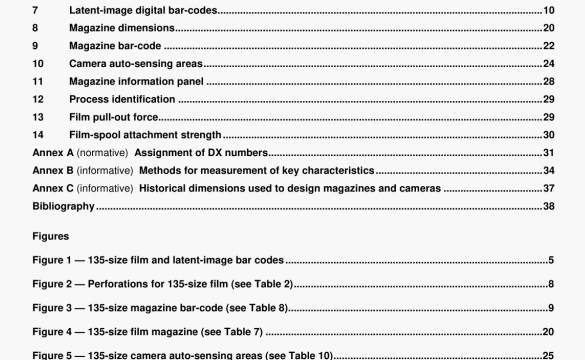ISO 1007 pdf download – Photography — 135-size film andmagazine-Specifications.
7.2.1.4 identifIcation array for part 2 of the DX number
The identification for part 2 ci the DX number is 4 bits, starling with bit 15 and ending with bit 18. Thés 4-bit array shall encode the specific part 2 DX number (specified in Table 4) that has been assigned to thai product under the procedure Specified in annex A. Any individeal location assigned as part of the part 2 DX number shall represent an exposed element (bar) Dashes (—) in Table 4 represent an unexposed element (space).
The 16 possible combinations of this array are encoded as a 4-bit binary number, with bar position number 15 representing the most significant bit, and bar position number 18 representing the least significant bit.
7.2.1.5 identIfIcation array for fram, numbers
This optional 7.blt array may be added to encode whole and half•frame numbers io accordance with the patterns given in Table 5. Bar positions 19 to 25 are a 7-bit binary representation of the frame number, with position number 19 representing the most significant bit and position number 25 representing the least significant bit, Frame numbers prior to the zero frame are denved by successive binary subtraction.
Bar position number 25 is exposed in those array’s that encode halt frame numbers. This is the half-frame llag’ Although the longest 1 35-size standard film length is 36 exposures. Table 5 provIdes me logical encodement for frame numbers greater than 36A in case these numbers should be needed in the future.
7.2.1.6 Second unassigned bit
A second unassigned bit shall be included in bit position 26 only if the optional frame-number array le included. The second unassigned bit shall be an unexposed element (space).
7.2.1.7 Parity bit
A parity bit shall be provided in bit position 19 in order to create even parity with data bits 7 through 18 Inclusive. (The total number of exposed elements Ibars) In data posItions 7 through 18, plus the panty bit position, shall be an even number,)
Under the optional dual-track frame-numbering system, the parity bit is used to create even parity with data bits 7 through 25 inclusive and is located in bit position 27.
The unassigned bits are part of this consideration, but since they are always spaces they have rio affect on the count of bars for parity.
7.2.1.8 Exit pattern
The exit pattern shall be 4 bEts as shown in Figure 1. It is used by a bar-code reader to detect the end of a code sequence.
It is the combination of the part 1 and part 2 numbers. together with the requirements given in this International Standard, that determine the actual bar-codes used on the product.
A.3.5 When a new product Is Introduced, the sensitizer shall report to PIMA the product name and the assigned two-part number.
PIMA records this information and issues a report annually. The report shall include the percent of part 1 codes assigned to sensitizers, each sensitizer’s company name, and a summary of the part 1 part 2 combination numbers, Including the product names being used by each sensitizer.
&3.6 All sensitizers shal confirm their intent to retain assigned part 1 DX numbers 36 months after the issuance dates
k3.7 Fm converters that want a two-part DX number shall request this information from the sensitizer. PIMA shall not assign DX numbers to converters.
*38 A sensitizer may assign a number of products to a single DX number In such cases, all products shall be of the same process, e.g. colour negative, cx black and white.
It is preferred that a sensitizer not assign more than one combination DX number to a single I ib’n.
A.4 Expanded capacity of the magazine bar-code
The capacity of the magazine bar-code (MBC) system has been expanded by the method outlined below. This has been done to enlarge the utility of the MBC in photofinishing operations by permitting additional difierentiation of product characteristics. The method also ensures that PIMA can maintain adequate control over the allocation of DX ni,inibers and circumvents the danger of ditlerent sensitizers using the same magazine bar-code I or different types 01 information.
As noted, the tofal number of available part 1 DX numbers is 128 (0 through 127), This limit is imposed by the restricted number of bits in the latent image bar-code (LIBC). However, the magazine bar-code can be expanded by supplementing each part 1 DX number in incremenls of 128, up to and including number 511. For example, pail I DX number 83 can be supplemented with numbers 211 (83 ÷ 128); 339 (83 + 128 + 128); and 467(83 • 128. 128 + 128).
These lncremenlal” numbers have been added to the basic part 1 DX numbers assigned to sensitizers. They can be used to differentiate magazines without impact on the LIBC, but mere is no obligation to use er renew them. Oniy the basic part 1 DX numbers (0 through 127) must be renewed, see A3.6 J. However, when augmented magazine bar-code numbers are used by a sensitizer, full information about affected products should be sent to PIMA for record keeping and incorporation in its annual report.
ISO 1007 pdf download – Photography — 135-size film andmagazine-Specifications
